Reviewer's Note: This is a round-up review of all of the new Infinitum line of Olight lights. Lights were supplied by MattK of batteryjunction.com
Warning: Even more pic heavy than usual!

The Infinitum series is a new line of lights by Olight. Similar in overall design and build to their classic T-series, these new I-series light feature a continuously-variable user interface. The UI is similar to that developed by ITP and subsequently used in the Olight Titanium Infinitum.
Since the interface is common to all members of the I-series, I have decided to review them all in one massive round-up review thread. :sweat: Following a general discussion of the common build and features of these light, individual comparisons of each light to its respective Olight T-series and ITP counterparts will be presented.
Common specs for I-series (adapted from manufacturer/dealer sources):
I10: Uses 1 x CR123A battery / 3v-4.2v RCR123A battery
I15: Uses 1 x AA battery / 1X1.2V Rechargeable. battery / 1X 3.7V 14500 battery
I20: Uses 2 x CR123A / 2 x RCR123A batteries / 1 x 17670 or 14670 battery
I25: Uses 2 x AA batteries / 2X1.2V Rechargeable batteries.

Shown above is the packaging for the I25, but the others are similar (except for a more basic wrist lanyard included with the other models). Included with all lights is a wrist lanyard, extra o-rings, spare clear GITD tailcap button cover, decent belt holster and manual.
The I-series lights all share a similar build to the classic Olight T-series. In fact, the heads/bodies/tailcaps of the T-series are interchangeable with these new I-series lights. :thumbsup: Note that the T-series use a reverse-clicky, whereas the I-series uses a forward-clicky.
Full detailed pics will be provided for each light in its own section at the end of this review, but for now I will provide an overview of the common build upgrades.

(from left to right: I10, I15, I20, I25)
The reflectors are unaltered from the previous T-series lights. The I10 and I15 share the same head, and use a similar reflector to the I20 (partial orange peel – textured at the base, smooth at opening). This same reflector is also in use in the ITP C7/C8/C9 series lights. Like the T25 before it, the I25 uses a full textured reflector.
All pics are taken ~0.5m from a white wall, on Max (AW protected RCR for I10, AW protected 14670 for I20, 2xAA Sanyo Eneloop for I25).




Since the reflectors are unaltered from the T-series or ITP lights, I haven't bothered doing direct beamshot comparisons to other lights. Please see my 1xAA, 2xAA, and 1xCR123A/RCR Round-up Reviews for comparisons of the T-series/ITP to other lights of the same class.

As before, the I10 and I15 share the same head and tailcap – they differ only in the length of the battery tube (I10 shown above, scroll down for more detailed pics). You could thus pick up an extra battery tube to complement the model you don't have.
Aside from the new circuitry, the main physical changes from the T10/T15 are the protruding forward clicky and an anti-roll ring at the head of the battery tube. This anti-roll ring covers the gap between the head and body that was visible on the T10/T15.

The I20 has similar circuit and tailcap upgrades over the T10, and now also includes a removable bezel-pointing clip attached to the tail region of the battery tube. It is secured in place by its own cover/grip ring (unscrew the ring to remove the clip, screw back down to cover the gap where the clip attaches).

The I25 uses a similar mechanism to the I20 to secure its clip, except that the clip is attached to the head of the battery tube and points toward the tailcap.
Personally, I like this new body design, as it allows easy removal of the clip without leaving a gap. The gap/cover rings are also textured to enhance grip.
The gap/cover rings are also textured to enhance grip.
For more detailed pics of each member of this I-series family, please scroll to the individual light overviews below.
I10: Weight 42.0g, Length 93.4mm, Width (bezel) 21.6mm
I15: Weight 52.5g, Length 110mm, Width (bezel) 21.6mm
I20: Weight 68.9g, Length 128mm, Width (bezel) 25.3mm
I25: Weight 87.9g, Length 159mm, Width (bezel) 25.6mm
Build Quality
Overall build quality is very high – at least as high as the original Olight T-series, and higher than the ITP lights, IMO. The new physical design features (anti-roll, clip, and clip-attachment point gap covers - depending on the model), are a step-up from original T-series.
Lights can no longer tailstand, but that's understandable given the new common forward clicky. Clicky witch has good feel with normal traverse.
Screw threads are of good quality on all lights, though a bit thin (necessary to keep backward capability with T-series body parts). Tailcap threads are anodized, allowing for tailcap lockout. :thumbsup:
Fit and finish is very good on all samples, with no discolorations or chipping. Anodizing is type III (hard anodized), and lettering is reasonably sharp and clear (but could be a bit thicker, especially on the Infinitum label and model number).
Battery tubes are wide enough to accommodate protected or higher capacity cells, except for the I20 which shares the same limitation as the T20 (i.e. my AW protected 17670 cells won't fit, so I need to use 14670 for runtimes). I was able to get my AW protected RCRs (16340) to fit fine in the I20.
Features and User Interface
The new Infinitum line features an updated version of the ITP continuously-variable interface.
All lights come with a forward clicky and three output modes: constant illumination, tactical strobe, and SOS mode. Press for momentary on, click for lock-on. You switch between states by soft-pressing the clicky, or turning the light off/on, with ~3 secs. If you leave it off longer than 3 secs, the light will come back on at constant-on at whatever level you last memorized it at (see below).
Like all continuously-variable lights, the I-series lights use PWM for their lower output modes. But the frequency is high enough that I can't detect it by eye or instrument. :thumbsup:
Strobe on the I-series lights was measured at a "tactical" (and dizzying) 12.7Hz on my samples. :green:
The continuously-variable UI is remarkably straight-forward: to activate the ramp, simply loosen the head slightly. This immediately starts the output ramping. When the light reaches the level you like, simply tighten the head to memorize that setting. To reverse the direction of the ramp, tighten and loosen the head again.
Note that unlike most of the continuously-variable competition, you don't need to perform a rapid twist switch or click repeatedly within a narrow time-window. Just loosen the head to start the ramp, tighten to save the setting. Very simple and intuitive.
Testing Method: All my output numbers are relative for my home-made light box setup, a la Quickbeam's flashlightreviews.com method. You can directly compare all my relative output values from different reviews - i.e. an output value of "10" in one graph is the same as "10" in another. All runtimes are done under a cooling fan.
Throw values are the square-root of lux measurements taken at 1 meter from the lens, using a light meter.
Throw/Output Summary Chart:
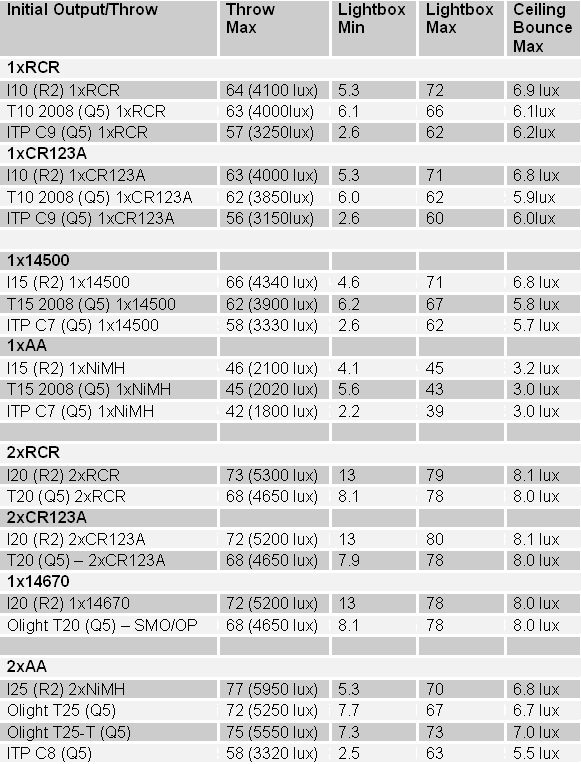
No real surprises here on Max – the lights perform largely as expected. Max output of the I15 on 1xNiMH AA is a bit lower than most lights in this category, but is comparable to the earlier ITP C7 and Olight T15.
On Min, the I-series lights are typically intermediate between their ITP and Olight T-series counterparts. The exception is the I20 – my sample doesn't go as low as my T20.
I am a bit surprised by these results, since most continuously-variable lights can go even lower.
To compare to other lights, please see my respective 1xAA, 2xAA, and 1xCR123A/RCR Round-up Review threads.
Scroll down for runtime graphs to see how the new I-series line up compares to the Olight T-series and ITP lights.
Variable Output Ramping

A representative ramp comparison is shown above for the I25. Ramping time has been reduced from the original ITP – it now takes only 2-3 series to complete the ramp, and there are no flashes to indicate the min or max positions.
Scroll down to the end of this review for a final commentary and general discussion of these I-series lights.
--------------------------------------
I10 Comparison

From left to right, Duracell CR123A, Olight I10, T10, ITP C9



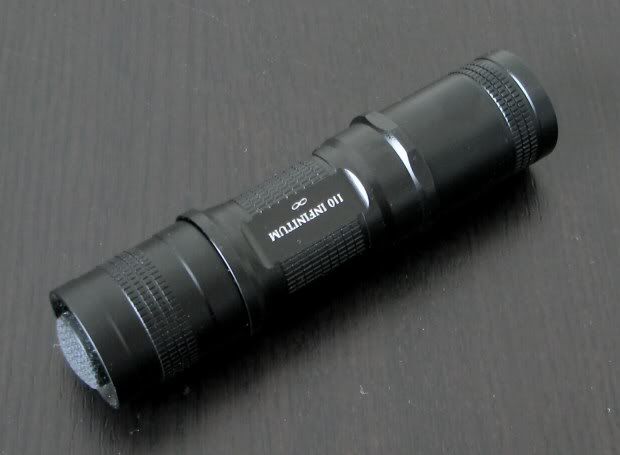


Output/Runtime Comparison:




--------------------------------------
I15 Comparison

From left to right, Duracell AA, Olight I15, T15, ITP C7







Output/Runtime Comparison:

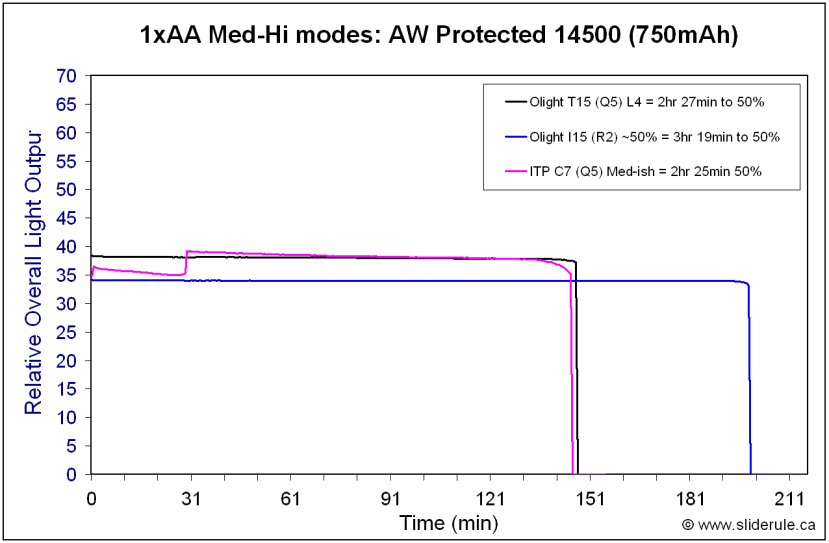
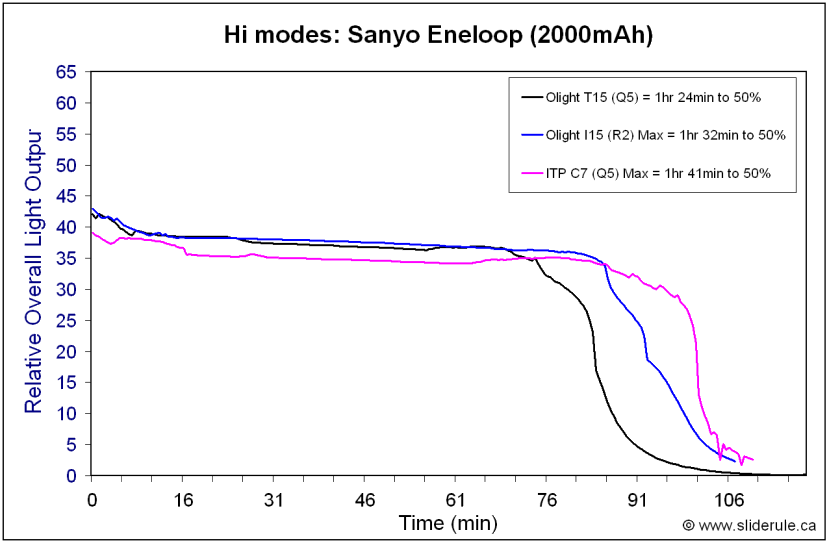
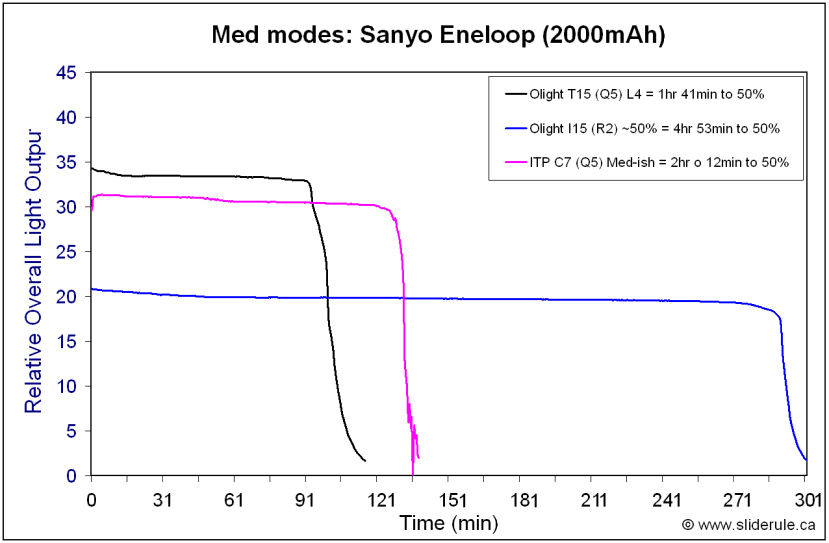



--------------------------------------
I20 Comparison

From left to right, Duracell CR123A, Olight I20, T20, M20, ITP C6






Output/Runtime Comparison:
Note that the I20 and T20 runs are on lower capacity 14670, not 18650 like the competition.






--------------------------------------
I25 Comparison

From left to right, Duracell AA, Olight I25, T25, T25 Tactical, ITP C8






Output/Runtime Comparison:





----------------------------------
Output/Runtime Pattern
Obviously, there is a lot of data to sort through up there. :sweat: But to give you the short version:
Minimum output of the I-series is not that much lower than the comparable T-series (and in fact the I20 Min is actually brighter than the T20 on Lo).
Ramp speed is relatively fast at 2-3 secs from Min to Max.
If you flash the light in momentary mode repeatedly in a short period of time, you will advance to strobe and then SOS mode. You need to wait ~3 secs between activations to come back on in constant-on.
Preliminary Observations
No beating around the bush - I think this new I-series is a nice upgrade to both the original Olight T-series and ITP line-ups. Olight has taken the ITP continuously-variable design, tweaked it, and incorporated it into an upgraded T-series with R2 emitters. What's not to love? :kiss:
Personally, I like the new build features of the I-series lights, although most of these are incremental improvements over the T-series. That being said, I'm sure the forward clicky will find favour here. Olights have always had a solid feel to me, and these lights are no different. A nice touch that they have kept the sizing and screw threads the same as the older T-series - so you can still perform mix-and-match "lego" on the various tailcap/battery tube components across the two series (where appropriate).
Olights have always had a solid feel to me, and these lights are no different. A nice touch that they have kept the sizing and screw threads the same as the older T-series - so you can still perform mix-and-match "lego" on the various tailcap/battery tube components across the two series (where appropriate).
There are also some tweaks to the ITP circuit. Readers of my reviews will know that I am a fan of this simple intuitive head loosen/tighten interface for the continuously-variable ramp. Ramping time has been increased (not really a plus for me, but I know others like it faster). But the circuit has also been customized to work well with a forward clicky (previous "tactical" versions of the ITP lights lacked strobe/SOS, which were only available on lights coupled with a reverse clicky). Again, I see these as refinements to an existing line - but generally welcomed ones. However, if you like to repeatedly flash the light in momentary mode, you had better wait ~3 secs in-between each flash (or you will find yourself getting strobed).
One area that could still stand improvement is the minimum output level. One of the advantages of PWM-based lights is the ability to run at far lower levels than current-controlled lights (like the T-series). The original ITP lights don't go as low as many of the competing continuously-variable lights, and the I-series lights are actually a bit brighter on their lowest level. To put that in perspective, the I-series lights are only slightly dimmer on Min than their corresponding T-series counterparts (and the I20 is in fact brighter than the T20). :thinking: Given the lower efficiency of PWM, this means you won't see any significant improvement in max runtime of the I-series over the T-series, even with the I-series R2 emitters. :shrug:
Which brings up my last point – it's good to see the Cree R2s being used here (and bonus: all were a premium "cool white" tint on my samples). Matt informs me that the Cree R2s used are actually sourced in the U.S., and shipped to Olight in China for assembly. This raises their cost, but insures reliable supply. R2s (especially premium tint) are still not available in quantity, and there is some concern that local Chinese distributors may be supplying re-labelled Q5s to manufacturers. The end result is that you can expect the true R2-lights to have slightly greater output over the Q5 T-series lights, and boosted efficiency over the Q5 ITP lights.
Basically, I look at the I-series as a merger of the best features of the ITP and Olight T-series lights, with a few upgrades and tweaks thrown in for good measure. The best of both worlds.
P.S.: I have added the results of the various I-series lights to my corresponding Round-up Reviews, so check those out to see how the lights compare to others of the same class.
Warning: Even more pic heavy than usual!

The Infinitum series is a new line of lights by Olight. Similar in overall design and build to their classic T-series, these new I-series light feature a continuously-variable user interface. The UI is similar to that developed by ITP and subsequently used in the Olight Titanium Infinitum.
Since the interface is common to all members of the I-series, I have decided to review them all in one massive round-up review thread. :sweat: Following a general discussion of the common build and features of these light, individual comparisons of each light to its respective Olight T-series and ITP counterparts will be presented.
Common specs for I-series (adapted from manufacturer/dealer sources):
- Cree XR-E R2 LED
- Modes: Illumination (Digital infinite beam adjustment); Strobe; SOS
- Tactical momentary-on forward switch, protruding switch for easy momentary or click to lock on
- Auto memorization of the current brightness level when power off.
- Linear ramping of output levels
- Superior heat sink that disperses heat to protect LED and electrical components
- Ergonomic design with solid structure for easy operation
- Partial smooth/orange peel reflector on most models, full orange peel reflector on I25
- Mil-spec: MIL-STD-810F
- Highly Water resistant
- Anti-shattering ultra clear lens, anti-scratching and anti-slip
- Lock-out function to prevent accidental activation
- Engineered anti-slip body texture that give you a firm tight grip
I10: Uses 1 x CR123A battery / 3v-4.2v RCR123A battery
I15: Uses 1 x AA battery / 1X1.2V Rechargeable. battery / 1X 3.7V 14500 battery
I20: Uses 2 x CR123A / 2 x RCR123A batteries / 1 x 17670 or 14670 battery
I25: Uses 2 x AA batteries / 2X1.2V Rechargeable batteries.

Shown above is the packaging for the I25, but the others are similar (except for a more basic wrist lanyard included with the other models). Included with all lights is a wrist lanyard, extra o-rings, spare clear GITD tailcap button cover, decent belt holster and manual.
The I-series lights all share a similar build to the classic Olight T-series. In fact, the heads/bodies/tailcaps of the T-series are interchangeable with these new I-series lights. :thumbsup: Note that the T-series use a reverse-clicky, whereas the I-series uses a forward-clicky.
Full detailed pics will be provided for each light in its own section at the end of this review, but for now I will provide an overview of the common build upgrades.

(from left to right: I10, I15, I20, I25)
The reflectors are unaltered from the previous T-series lights. The I10 and I15 share the same head, and use a similar reflector to the I20 (partial orange peel – textured at the base, smooth at opening). This same reflector is also in use in the ITP C7/C8/C9 series lights. Like the T25 before it, the I25 uses a full textured reflector.
All pics are taken ~0.5m from a white wall, on Max (AW protected RCR for I10, AW protected 14670 for I20, 2xAA Sanyo Eneloop for I25).




Since the reflectors are unaltered from the T-series or ITP lights, I haven't bothered doing direct beamshot comparisons to other lights. Please see my 1xAA, 2xAA, and 1xCR123A/RCR Round-up Reviews for comparisons of the T-series/ITP to other lights of the same class.

As before, the I10 and I15 share the same head and tailcap – they differ only in the length of the battery tube (I10 shown above, scroll down for more detailed pics). You could thus pick up an extra battery tube to complement the model you don't have.
Aside from the new circuitry, the main physical changes from the T10/T15 are the protruding forward clicky and an anti-roll ring at the head of the battery tube. This anti-roll ring covers the gap between the head and body that was visible on the T10/T15.

The I20 has similar circuit and tailcap upgrades over the T10, and now also includes a removable bezel-pointing clip attached to the tail region of the battery tube. It is secured in place by its own cover/grip ring (unscrew the ring to remove the clip, screw back down to cover the gap where the clip attaches).

The I25 uses a similar mechanism to the I20 to secure its clip, except that the clip is attached to the head of the battery tube and points toward the tailcap.
Personally, I like this new body design, as it allows easy removal of the clip without leaving a gap.
For more detailed pics of each member of this I-series family, please scroll to the individual light overviews below.
I10: Weight 42.0g, Length 93.4mm, Width (bezel) 21.6mm
I15: Weight 52.5g, Length 110mm, Width (bezel) 21.6mm
I20: Weight 68.9g, Length 128mm, Width (bezel) 25.3mm
I25: Weight 87.9g, Length 159mm, Width (bezel) 25.6mm
Build Quality
Overall build quality is very high – at least as high as the original Olight T-series, and higher than the ITP lights, IMO. The new physical design features (anti-roll, clip, and clip-attachment point gap covers - depending on the model), are a step-up from original T-series.
Lights can no longer tailstand, but that's understandable given the new common forward clicky. Clicky witch has good feel with normal traverse.
Screw threads are of good quality on all lights, though a bit thin (necessary to keep backward capability with T-series body parts). Tailcap threads are anodized, allowing for tailcap lockout. :thumbsup:
Fit and finish is very good on all samples, with no discolorations or chipping. Anodizing is type III (hard anodized), and lettering is reasonably sharp and clear (but could be a bit thicker, especially on the Infinitum label and model number).
Battery tubes are wide enough to accommodate protected or higher capacity cells, except for the I20 which shares the same limitation as the T20 (i.e. my AW protected 17670 cells won't fit, so I need to use 14670 for runtimes). I was able to get my AW protected RCRs (16340) to fit fine in the I20.
Features and User Interface
The new Infinitum line features an updated version of the ITP continuously-variable interface.
All lights come with a forward clicky and three output modes: constant illumination, tactical strobe, and SOS mode. Press for momentary on, click for lock-on. You switch between states by soft-pressing the clicky, or turning the light off/on, with ~3 secs. If you leave it off longer than 3 secs, the light will come back on at constant-on at whatever level you last memorized it at (see below).
Like all continuously-variable lights, the I-series lights use PWM for their lower output modes. But the frequency is high enough that I can't detect it by eye or instrument. :thumbsup:
Strobe on the I-series lights was measured at a "tactical" (and dizzying) 12.7Hz on my samples. :green:
The continuously-variable UI is remarkably straight-forward: to activate the ramp, simply loosen the head slightly. This immediately starts the output ramping. When the light reaches the level you like, simply tighten the head to memorize that setting. To reverse the direction of the ramp, tighten and loosen the head again.
Note that unlike most of the continuously-variable competition, you don't need to perform a rapid twist switch or click repeatedly within a narrow time-window. Just loosen the head to start the ramp, tighten to save the setting. Very simple and intuitive.
Testing Method: All my output numbers are relative for my home-made light box setup, a la Quickbeam's flashlightreviews.com method. You can directly compare all my relative output values from different reviews - i.e. an output value of "10" in one graph is the same as "10" in another. All runtimes are done under a cooling fan.
Throw values are the square-root of lux measurements taken at 1 meter from the lens, using a light meter.
Throw/Output Summary Chart:

No real surprises here on Max – the lights perform largely as expected. Max output of the I15 on 1xNiMH AA is a bit lower than most lights in this category, but is comparable to the earlier ITP C7 and Olight T15.
On Min, the I-series lights are typically intermediate between their ITP and Olight T-series counterparts. The exception is the I20 – my sample doesn't go as low as my T20.
I am a bit surprised by these results, since most continuously-variable lights can go even lower.
To compare to other lights, please see my respective 1xAA, 2xAA, and 1xCR123A/RCR Round-up Review threads.
Scroll down for runtime graphs to see how the new I-series line up compares to the Olight T-series and ITP lights.
Variable Output Ramping

A representative ramp comparison is shown above for the I25. Ramping time has been reduced from the original ITP – it now takes only 2-3 series to complete the ramp, and there are no flashes to indicate the min or max positions.
Scroll down to the end of this review for a final commentary and general discussion of these I-series lights.
--------------------------------------
I10 Comparison

From left to right, Duracell CR123A, Olight I10, T10, ITP C9






Output/Runtime Comparison:




--------------------------------------
I15 Comparison

From left to right, Duracell AA, Olight I15, T15, ITP C7







Output/Runtime Comparison:







--------------------------------------
I20 Comparison

From left to right, Duracell CR123A, Olight I20, T20, M20, ITP C6






Output/Runtime Comparison:
Note that the I20 and T20 runs are on lower capacity 14670, not 18650 like the competition.






--------------------------------------
I25 Comparison

From left to right, Duracell AA, Olight I25, T25, T25 Tactical, ITP C8






Output/Runtime Comparison:





----------------------------------
Output/Runtime Pattern
Obviously, there is a lot of data to sort through up there. :sweat: But to give you the short version:
- The regulation pattern and performance of these new I-series lights is is generally excellent.
- The I-series are typically brighter and longer lasting on Max than either their ITP of T-series brethren. :thumbsup: This is likely due to the higher flux R2 emitters used on the I-series.
- On ~50%, the I-series (R2) lights are typically still more efficient than the ITP (Q5) lights, but the T-series (Q5) lights begin to close the gap. This is as expected, since the defined output current-controlled circuitry of the T-series has a relative efficiency advantage (even though coupled with the lower flux Q5 emitters). Although not tested, on Lo/Min, I suspect the T-series lights would at least match or potentially exceed the efficiency of the I-series
Minimum output of the I-series is not that much lower than the comparable T-series (and in fact the I20 Min is actually brighter than the T20 on Lo).
Ramp speed is relatively fast at 2-3 secs from Min to Max.
If you flash the light in momentary mode repeatedly in a short period of time, you will advance to strobe and then SOS mode. You need to wait ~3 secs between activations to come back on in constant-on.
Preliminary Observations
No beating around the bush - I think this new I-series is a nice upgrade to both the original Olight T-series and ITP line-ups. Olight has taken the ITP continuously-variable design, tweaked it, and incorporated it into an upgraded T-series with R2 emitters. What's not to love? :kiss:
Personally, I like the new build features of the I-series lights, although most of these are incremental improvements over the T-series. That being said, I'm sure the forward clicky will find favour here.
There are also some tweaks to the ITP circuit. Readers of my reviews will know that I am a fan of this simple intuitive head loosen/tighten interface for the continuously-variable ramp. Ramping time has been increased (not really a plus for me, but I know others like it faster). But the circuit has also been customized to work well with a forward clicky (previous "tactical" versions of the ITP lights lacked strobe/SOS, which were only available on lights coupled with a reverse clicky). Again, I see these as refinements to an existing line - but generally welcomed ones. However, if you like to repeatedly flash the light in momentary mode, you had better wait ~3 secs in-between each flash (or you will find yourself getting strobed).
One area that could still stand improvement is the minimum output level. One of the advantages of PWM-based lights is the ability to run at far lower levels than current-controlled lights (like the T-series). The original ITP lights don't go as low as many of the competing continuously-variable lights, and the I-series lights are actually a bit brighter on their lowest level. To put that in perspective, the I-series lights are only slightly dimmer on Min than their corresponding T-series counterparts (and the I20 is in fact brighter than the T20). :thinking: Given the lower efficiency of PWM, this means you won't see any significant improvement in max runtime of the I-series over the T-series, even with the I-series R2 emitters. :shrug:
Which brings up my last point – it's good to see the Cree R2s being used here (and bonus: all were a premium "cool white" tint on my samples). Matt informs me that the Cree R2s used are actually sourced in the U.S., and shipped to Olight in China for assembly. This raises their cost, but insures reliable supply. R2s (especially premium tint) are still not available in quantity, and there is some concern that local Chinese distributors may be supplying re-labelled Q5s to manufacturers. The end result is that you can expect the true R2-lights to have slightly greater output over the Q5 T-series lights, and boosted efficiency over the Q5 ITP lights.
Basically, I look at the I-series as a merger of the best features of the ITP and Olight T-series lights, with a few upgrades and tweaks thrown in for good measure. The best of both worlds.
P.S.: I have added the results of the various I-series lights to my corresponding Round-up Reviews, so check those out to see how the lights compare to others of the same class.
Last edited:



